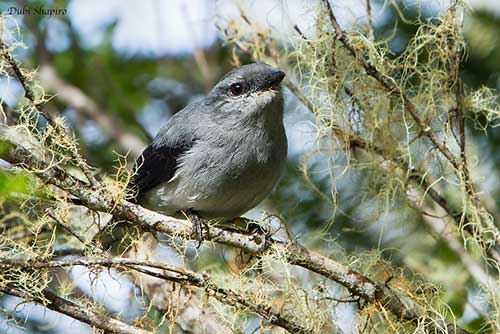
On the head, crown to nape is grey. There is a blackish spot in front of the eye. The ear-coverts are dull grey and we can see some white spots below the eye.
Bill, legs and feet are blackish. The eyes are brown.
It differs from the Mauritius Cuckooshrike by the paler grey underparts.
The Reunion Cuckooshrike adult female has dark rusty-brown upperparts with indistinct rusty bars on rump and undertail-coverts. The upperwing-coverts are dark brown with paler lesser coverts. The flight-feathers have rusty-brown edges, except the primaries with whitish-brown fringes. The tail is dark brown with buffy-white tip.
The underparts are whitish with fine, dull dark barring. Breast and flanks are tinged fulvous but central belly and undertail-coverts are white.
There is a conspicuous narrow white eyebrow and a blackish eyestripe. Lores and upper ear-coverts are blackish-brown. Cheeks and lower ear-coverts are buffy-white with fine blackish spots.
The juvenile resembles female but the upperparts are barred pale buff and dark brown.
RANGE:
The Reunion Cuckooshrike is found in NW Reunion Island where it occurs in only two areas: Plaine d’Affouches and Plaine des Chicots.
HABITAT:
The Reunion Cuckooshrike is associated with natural forest, and usually restricted to the canopy. It is found in mixed evergreen subtropical forest with patches of heath (Philippa montana) and tamarin (Acacia heterophylla). The species is visible between 1,000 and 1,800 metres of elevation.
CALLS AND SONGS: SOUNDS BY XENO-CANTO
The song of the Reunion Cuckooshrike is a clear whistled described as a soft “tweet-weet-weet-weet-weet” and variants, giving the bird its local name “Tuit-tuit”.
During aggressive behaviour, it gives a harsh “crik” or “gek” and when alarmed, a harsher “shrrr”. Male and female also produce aggressive squeak.
BEHAVIOUR IN THE WILD:
The Reunion Cuckooshrike feeds primarily on insects such as adults and larval Coleopterans, especially Cerambycidae species. Numerous other insect species and also spiders are part of the diet. Fruits of native plant and tree species such as Aphloia and Ficus are taken too.
It forages mainly at upper level in the forest and often among open branches. It gleans prey from the vegetation, leaves, branches and tree trunks by moving slowly and making short strikes, or hovering to reach higher leaves. It may sometimes probe bark and lichens.
The Reunion Cuckooshrike is territorial and monogamous, with pair-bond usually lasting one year. The territory is maintained year-round. Both adults take part in nesting duties.
This species is resident with only some post-breeding dispersal.
The flight is agile while the bird is foraging.
REPRODUCTION OF THIS SPECIES:
The breeding season takes place between September and February. The Reunion Cuckooshrike may produce two broods per year.
Both adults build a small, cup-shaped nest with twigs, moss and lichens bound together with spider webs. It is placed in tree fork high in tree, between 4 and 17 metres above the ground.
The female lays 2-3 eggs. The incubation lasts 15-17 days. The chicks fledge 20-23 days after hatching.
PROTECTION / THREATS / STATUS:
The Reunion Cuckooshrike has very restricted range on Reunion Island.
The main threats include nest predation by cats and rats, competition for food with the Red-whiskered Bulbul, poaching for trade and food, disturbance caused by recreational activities and degradation of the habitat by invasive exotic vegetation and forest fires.
The population was estimated at 25 breeding pairs (50 mature individuals) in 2007. In 2011, there were 31 pairs and 28 non-breeding males, and still 33 pairs in 2013. The population of mature individuals is still declining.
The Reunion Cuckooshrike is currently classified as Critically Endangered.
Fr: Échenilleur de la Réunion - Echenilleur cuisenier
Ang: Reunion Cuckooshrike
All: Newtonraupenfänger
Esp: Oruguero de Reunión
Ita: Averla cuculo di Reunion
Nd: Réunionrupsvogel
Sd: réuniongråfågel
Photographer:
Dubi Shapiro
Dubi Shapiro Photo Galleries & Dubi Shapiro's Pictures on IBC
Text by Nicole Bouglouan
Sources:
HANDBOOK OF THE BIRDS OF THE WORLD Vol 10 by Josep del Hoyo-Andrew Elliott-David Christie - Lynx Edicions - ISBN: 8487334725
Birds of Madagascar and the Indian Ocean Islands Par Roger Safford, Adrian Skerrett, Frank Hawkins – ISBN: 1472924118, 9781472924117- Editeur: Bloomsbury Publishing, 2015
The Birds of Africa: Volume VIII: The Malagasy Region: Madagascar, Seychelles, Comoros, Mascarenes - Par Roger Safford, Frank Hawkins – ISBN: 1408190494, 9781408190494- Editeur: A&C Black, 2013
Taylor & Francis Online - L'échenilleur de La Réunion
Wikipedia, the free encyclopaedia
Home page
Page Passeriforme Order
Reunion Cuckooshrike
Lalage newtoni
Passeriformes Order – Campephagidae Family
INTRODUCTION:
The Reunion Cuckooshrike is endemic to Reunion Island. This bird is very rare and has very restricted range with only two areas of about 16 km² in mountain forest in NW Reunion.
This species is arboreal and is usually restricted to the canopy. It is rarely seen in low vegetation. It is primarily insect-eater but it also consumes some fruits.
The Reunion Cuckooshrike is territorial and monogamous. The cup-shaped nest is placed in tree fork and both adults share the nesting duties.
The Reunion Cuckooshrike is threatened by degradation of the habitat, predation by cats and rats, poaching for trade and food and human disturbance. This species is currently classified as Critically Endangered.
DESCRIPTION OF THE BIRD:
Biometrics:
Length: 22 cm
Weight: 40 gr
The Reunion Cuckooshrike adult male has grey upperparts and head. The upperwing is black with narrow grey edges on wing-coverts, whereas primaries and secondaries show whitish edges and tips. Rump and uppertail-coverts are paler grey and the tail is black with white tip.
Chin and upper throat are greyish-white. The underparts are pale grey with white central belly, undertail-coverts and underwing-coverts.
